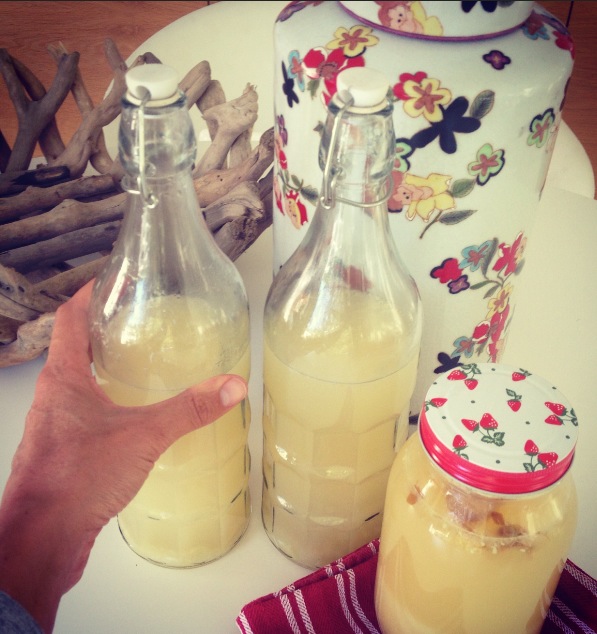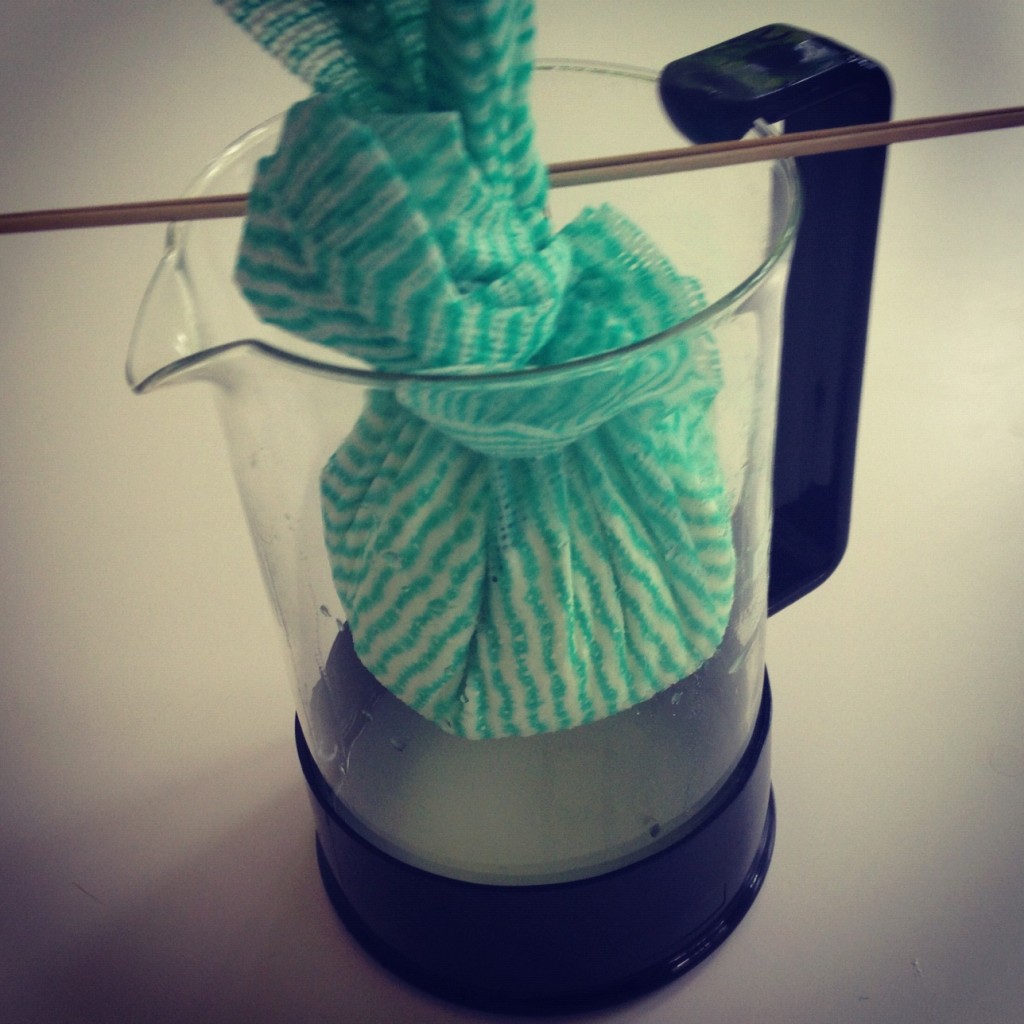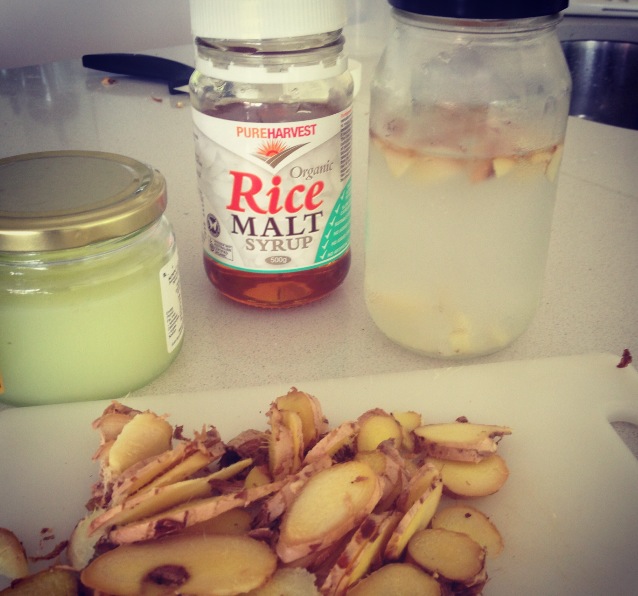Do you fit one or several of these scenarios? Gone sugar free, but crave a “sweet” soft drink/soda, especially on hot days? Want a healthy drink to give the kids? Got gut issues and need to up the probiotics in your diet? Need more electrolytes? I think I have the answer: homemade ginger-ade.

I kind of got obsessed about this stuff, researching the different ways to make it, and, over the course of a week, I tried out four variations, and made two starter cultures. And did a lot of obsessed checking and shaking and fiddling in the kitchen (you’ll have to scroll to the end of the post to see my verdict – which was the best combo).
To back peddle: ginger-ade is a fermented food. I’ve written about the benefits of fermenting, and shared recipes, here and here. Fermentation – in the case of sodas – is a process that sees sugar broken down, via bacteria, to create lactic acid and carbonation. Lactic acid is a probiotic which helps digestion, supports the immune system and hydrates.
Sugar?? Did I just say sugar??!! Yes.
Sugar is almost always used for making fermented sodas, but the fructose is “eaten” up in the process. Now, I’m a was a little dubious about whether all of it is used up. I couldn’t find an answer as to the exact amount of sugar left behind, but I did read that when a similar process is used to make water kefir (also made with sugar), after a 48-fermentation period 80 per cent of the sugar will be consumed by the bacteria. I’m imagining it will be much the same for this process. So, when extrapolated out, this means 25 g of sugar is left in 2L of the ginger-ade below. In one cup of the stuff, it’s 3.1g sugar. Which is about 3/4 teaspoon. If consumed with soda water (I find it works best half-ginger-ade-half-soda), then
one large glass will contain less than 1/2 teaspoon of sugar.
Which is not too bad at all.
That said, however, since so many of you are committed to cutting out all fructose, I tried out versions using fructose-free rice malt syrup and a combo of sugar and rice malt syrup. It seemed to work, although I was warned that when you use pure glucose (rice malt syrup or dextrose) the recipe requires longer fermentation periods.
But let’s make the stuff. Now. There are two steps. With several options entailed in each.
Step 1: Make a starter culture
There are three starter cultures you can use: baker’s yeast, whey and a “ginger bug”.
To make whey
This is simple – you follow my directions for making cream cheese. The leftover whey is what you use for ginger-ade.

A few things to remember:
* Whey from fully fermented milk no longer contains lactose
* It can heal gut dysbiosis, is high potassium and vitamin B2.
* Whey keeps for up to six months
To make a “ginger bug”
1 tbs. sugar
1 tbs fresh ginger, chopped with the peel left on
2 cups room temperature water
Combine the above in a mason jar (a jar with a tight lid) and let the wild bacteria and yeast do their work overnight. The next day, shake the jar, remove the lid. If it’s audibly fizzing, you’re onto a good thing. If not much action (this will be the case if it’s winter or a cold day), add an extra tablespoon each of sugar and ginger. I made mine on a mild day, added 1/2 tbls of each on the second day and left it out on the bench a total of 2 1/2 days. But it might take up to 4 days to get a fizz happening, from what I read.

Note: Always keep a little bit of the old ginger in the mason jar and reuse the same jar without rinsing it to make the next bug. The “older” the bug, the less fermenting time required.
Step 2: making the soda
As I say, there are different ways to make this – using different starter cultures and different types of sugars. Choose your own combo.
Ginger bug Ginger-ade
1 cup thinly sliced fresh ginger, unpeeled
1/2 cup sugar + 1/4 cup rice malt syrup OR 3/4 cup rice malt syrup
2 lemons (zest and juice)
6 cups water
½ cup ginger bug OR 1/2 cup whey
Bring water, sugar (either the blend or straight rice malt syrup), and sliced ginger to a boil in a medium pot. Simmer for 10 minutes. Cool to body temperature then add the zest and juice of 2 lemons (tip: if you have a Vitamix: trim the zest and blitz, trim the pith and discard, along with any pips, then add the whole lemon to the Vitamix and blitz again; pour the liquid over the top to combine). Transfer to a mason jar. Add the ginger bug OR whey.

Stir well and allow to sit on the counter for 2-3 days in hot weather, or until slightly bubbly. Stir occasionally. Strain the ginger-ade into bottles. Allow to carbonate for another 2-3 days at room temperature, chill, then consume. If you’re not going to consume straight away, place in the fridge straight away – it will keep fermenting even in the cold and last a week in the fridge before it goes vinegary. The longer it’s left to ferment, the tangier it will get.
You can also make ginger-ade using ginger powder and lime instead of fresh ginger and lemon.
Or you can make it using baker’s yeast. David Gillespie has a recipe on his site for a dextrose-based yeast-fermented ginger ale!
And the verdict? The best combination?
The whey versions were best – more well-rounded in flavour and less fiddly. And I liked the pure rice malt syrup version. It was definitely less sweet (which does suggest not all fructose is used up in the fermentation process), just as fizzy and “activated”. I did leave it out a day longer, as suggested above, which might explain why it was more tart as well.

